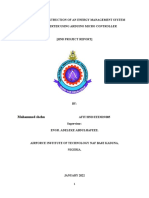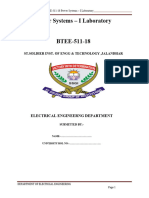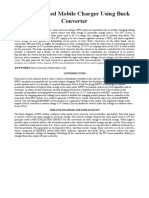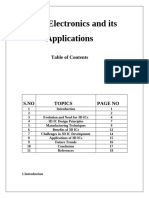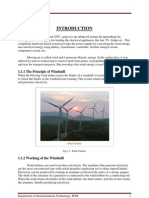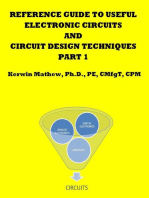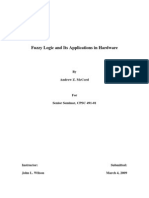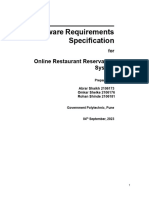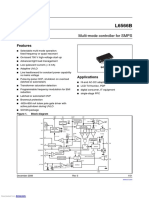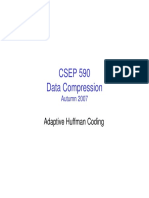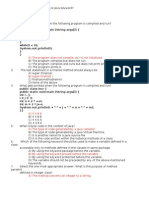Seminar Report Kiran
Seminar Report Kiran
Uploaded by
sreepraveen773Copyright:
Available Formats
Seminar Report Kiran
Seminar Report Kiran
Uploaded by
sreepraveen773Copyright
Available Formats
Share this document
Did you find this document useful?
Is this content inappropriate?
Copyright:
Available Formats
Seminar Report Kiran
Seminar Report Kiran
Uploaded by
sreepraveen773Copyright:
Available Formats
DEPARTMENT OF ELECTRICAL AND ELECTRONICS ENGINEERING
LIST OF CONTENTS
CHAPTER NAME PAGE
1 INTRODUCTION 2
2 SERIES INVERTER 3
3 OPERATION OF
SERIES INVERETER 4
4 CONNECTION 6
5 WORKING 7
CONNECTION DIAGRAM 9
6 ADVANTAGES 10
7 CHALLENGES 12
8 APPLICATIONS 13
CONCLUSION
REFERENCES
GOVERNMENT POLYTECHNIC COLLEGE PALAKKAD 1
DEPARTMENT OF ELECTRICAL AND ELECTRONICS ENGINEERING
CHAPTER 1
INTRODUCTION
A SOLAR INTERFACED SERIES INVERTER IS A DEVICE DESIGNED TO CONVERT DIRECT
CURRENT (DC) GENERATED BY SOLAR PANELS INTO ALTERNATING CURRENT (AC)
THAT CAN BE USED TO POWER HOUSEHOLD OR INDUSTRIAL APPLIANCES. IT’S
CALLED A “SERIES” INVERTER BECAUSE IT’S TYPICALLY USED IN A CONFIGURATION
WHERE MULTIPLE SOLAR PANELS ARE CONNECTED IN SERIES TO INCREASE THE
VOLTAGE OUTPUT. THIS TYPE OF INVERTER PLAYS A CRUCIAL ROLE IN HARNESSING
RENEWABLE ENERGY FROM SOLAR SOURCES AND INTEGRATING IT INTO EXISTING
ELECTRICAL GRIDS. IT HELPS OPTIMIZE ENERGY PRODUCTION AND CONTRIBUTES TO
A MORE SUSTAINABLE AND ECO-FRIENDLY POWER GENERATION SYSTEM.
GOVERNMENT POLYTECHNIC COLLEGE PALAKKAD 2
DEPARTMENT OF ELECTRICAL AND ELECTRONICS ENGINEERING
CHAPTER 2
SERIES INVERTER
The inverter circuit in which the commutating elements L and C are connected in
series with the load to form an under damped circuit is called a series inverter. This
circuit is also called load commutated or selfcommutated inverter. This circuit is
called load commutated inverter because the load component (L and C) is
responsible to turned off the thyristor. It is called self component (L commutated
inverter because in this circuit anode current itself become zero resulting the
thyristor turned off.T he Circuit Diagram of Series Inverter is shown in the figure. It
consists of two thyristors (TI and T2). The thyristor T1 and T2 are turn on
appropriately to get the output voltage of desired frequency. This circuit consist of L
and C connected in series with load .
GOVERNMENT POLYTECHNIC COLLEGE PALAKKAD 3
DEPARTMENT OF ELECTRICAL AND ELECTRONICS ENGINEERING
CHAPTER 3
OPERATION OF SERIES INVERETER
The whole operation is divided into 3 modes:
Mode -1(T1 on and T2 off):
In this mode we give firing pulse to thyristor T1 so, T1 get turned on and T2 thyristor
is turned off initially. So, current flow from supply Vs…..T1……load……back to Vs. The
nature of the load current is alternating due to under damped circuit. So, this time
capacitor © start charging gradually from -Vs to its max voltage. This time inductor
(L) also get charge. When the load current becomes maximum the voltage across
capacitor becomes + Vs. When the load current becomes zero at point a the voltage
across capacitor becomes +2Vs. Then the load current becomes zero the thyristor T1
automatically turns off at point a.
Mode-2(T1 and T2 both off):
This time thyristor T1 turns off because the load current becomes zero from point a
to b. In this time duration The thyristor T1 and T2 are turned off and voltage across
capacitor becomes equal to +2 Vs .
Mode-3(T1 off and T2 on):
In this mode we give firing pulse to thyristor T2. So, T2 get turned on. In this time
capacitor start discharging its energy from +2Vs to – Vs through thyristor T2 and R – L
circuit . Due to capacitor discharging reverse current flow across the load. Now at
point C thyristor T2 turns off automatically due to load current becomes zero. The
thyristor T2 turns off during point C to D and thyristor T1 again turns on. In this way
cycle repeat.
GOVERNMENT POLYTECHNIC COLLEGE PALAKKAD 4
DEPARTMENT OF ELECTRICAL AND ELECTRONICS ENGINEERING
Waveform
Voltage and current Wave form of Series Inverter 1) Ig1 is the gate pulse of thyristor
T1 2) Ig2 is the gate pulse of thyristor T2 3) Io (output current) 4) Vc (capacit or
voltage) 5) VL (Load voltage
GOVERNMENT POLYTECHNIC COLLEGE PALAKKAD 5
DEPARTMENT OF ELECTRICAL AND ELECTRONICS ENGINEERING
CHAPTER 4
CONNECTION
A solar interfaced series inverter connection typically refers to a setup where multiple
solar panels are connected in series and then connected to an inverter. In this
configuration, the positive terminal of one panel is connected to the negative terminal
of the next, and so on, until you have a string of panels.
This series connection increases the voltage output, but the current remains the same
as that of a single panel. The combined higher voltage is then fed into the inverter,
which converts the DC (direct current) power generated by the panels into AC
(alternating current) power suitable for use in homes or the electrical grid.
It’s important to ensure that the panels are compatible for series connection in terms of
voltage ratings. Also, consider factors like shading, as it can significantly impact the
GOVERNMENT POLYTECHNIC COLLEGE PALAKKAD 6
DEPARTMENT OF ELECTRICAL AND ELECTRONICS ENGINEERING
efficiency of a series-connected array. Consulting with a professional or referring to
the manufacturer’s guidelines for your specific panels and inverter is recommended
for a safe and efficient installation.
CHAPTER 5
WORKING
1. Solar Panels: The solar panels generate DC electricity when exposed
to sunlight. This DC electricity is produced in varying voltage levels
depending on factors like sunlight intensity and temperature.
2. Maximum Power Point Tracking (MPPT): The inverter often
incorporates Maximum Power Point Tracking technology. MPPT helps
optimize the power output from the solar panels by adjusting the
electrical operating point of the modules or array. It ensures that the
panels are operating at their most efficient point, especially when
environmental conditions change.
3. DC-DC Conversion: The DC electricity from the solar panels is
typically not at the same voltage level required for the inverter to function
optimally. The inverter includes a DC-DC converter that adjusts the
voltage level to a suitable range.
4. Series Connection: In a series inverter, solar panels are usually
connected in series. This means the positive terminal of one panel is
GOVERNMENT POLYTECHNIC COLLEGE PALAKKAD 7
DEPARTMENT OF ELECTRICAL AND ELECTRONICS ENGINEERING
connected to the negative terminal of the next panel, and so on. This
increases the total voltage output
5. Inversion Process: The DC electricity is then fed into an inverter
circuit. The inverter uses electronic components to convert the DC input
into AC output
6. Switching Operation: The series inverter uses a series of switching
devices (like transistors or thyristors) that are turned on and off in a
specific sequence. This switching creates an AC waveform.
7. Output Filtering: The AC waveform generated by the inverter may
not be a perfect sine wave. It might have some distortion. Therefore, it
passes through filters to smooth out the waveform and remove unwanted
harmonic
8. Synchronization with the Grid (if applicable): If the system is
grid-tied (connected to the electrical grid), the inverter must synchronize
the phase and frequency of the AC output with the grid. This ensures that
the solar-generated electricity can be safely fed back into the grid without
causing any disruptions.
9. Output to Load or Grid: The AC electricity produced by the
inverter can be used to power household appliances or, if excess energy is
generated, it can be fed back into the electrical grid.
10. Monitoring and Control: Many modern solar inverters come with
monitoring and control features. These allow users to track the
performance of the solar panels and inverter, monitor energy production,
GOVERNMENT POLYTECHNIC COLLEGE PALAKKAD 8
DEPARTMENT OF ELECTRICAL AND ELECTRONICS ENGINEERING
and sometimes even remotely control the system via a smartphone app or
a computer.
Connection diagram
MPPT – It maximize the energy available from the connected solar module
arrays at any time during its operation.
GOVERNMENT POLYTECHNIC COLLEGE PALAKKAD 9
DEPARTMENT OF ELECTRICAL AND ELECTRONICS ENGINEERING
Overall, a solar interfaced series inverter plays a crucial role in harnessing
the power of solar energy and making it compatible with the electrical
systems we use in our homes and businesses.
CHAPTER 6
ADVANTAGES
1. Efficient Energy Conversion: It efficiently converts the DC power
generated by solar panels into AC power for use in homes or to be fed back into
the grid.
2. Grid Integration: It allows for the seamless integration of solar power with
the existing electrical grid, enabling the user to draw power from the grid when
solar production is low and feed excess power back into the grid when
production is high.
GOVERNMENT POLYTECHNIC COLLEGE PALAKKAD 10
DEPARTMENT OF ELECTRICAL AND ELECTRONICS ENGINEERING
3. Reduced Electricity Costs: By harnessing solar energy, users can offset
their electricity bills. When the system generates more power than is consumed,
excess energy can be sold back to the grid.
4. Environmental Benefits: Solar power is a clean, renewable energy source
that reduces greenhouse gas emissions and dependence on fossil fuels.
5. Net Metering: Many regions offer net metering programs, which allow users
to receive credits on their utility bills for the excess energy they generate and
feed back into the grid.
6. Increased Property Value: Installing a solar system with a series inverter
can potentially increase the value of a property, as it demonstrates a
commitment to sustainability and reduced energy costs.
7. Low Maintenance: Series inverters are generally reliable and require
minimal maintenance once installed.
8. Modularity and Scalability: It’s relatively easy to add more solar panels
to an existing system, making it a scalable solution for increasing energy
production as needs grow.
GOVERNMENT POLYTECHNIC COLLEGE PALAKKAD 11
DEPARTMENT OF ELECTRICAL AND ELECTRONICS ENGINEERING
9. Reduced Grid Strain: By generating power close to where it’s consumed,
solar interfaced series inverters can help alleviate stress on the grid, especially
during peak demand periods.
10. Promotes Energy Independence: Solar power provides a degree of
energy independence, reducing reliance on centralized power generation and
vulnerable transmission lines.
CHAPTER 7
CHALLENGES
1. Single Point of Failure: In a series configuration, if one inverter fails, it can
affect the entire system’s performance.
2. Mismatch Issues: Series-connected inverters may face challenges if there are
variations in individual solar panel performance, as the system is only as strong
as its weakest link.
3. Reduced Efficiency in Partial Shading: Partial shading of one panel can
significantly impact the output of the entire series, leading to reduced overall
efficiency.
GOVERNMENT POLYTECHNIC COLLEGE PALAKKAD 12
DEPARTMENT OF ELECTRICAL AND ELECTRONICS ENGINEERING
4. Complex Maintenance: Troubleshooting and maintaining a series inverter
setup can be more complex compared to parallel configurations.
5. Cost: Initial installation costs for series inverters might be higher, especially
when additional components are needed for monitoring and control.
6. Limited Scalability: Expanding a series-connected system might require
careful consideration of matching new components with existing ones, limiting
scalability.
CHAPTER 8
APPLICATIONS
1. Residential Solar Power Systems: They can be used in homes where
series connection of solar panels is more efficient based on the roof layout and
shading conditions.
2. Commercial and Industrial Installations: Larger-scale solar power
installations on commercial or industrial buildings can benefit from series-
connected solar panels to maximize energy production.
3. Off-Grid Power Systems: In off-grid applications, such as remote areas or
standalone power systems, series inverters can be employed to harness solar
energy efficiently.
4. Solar Street Lighting: Series inverters can be utilized in solar street lighting
systems to enhance the performance of the integrated solar panels.
GOVERNMENT POLYTECHNIC COLLEGE PALAKKAD 13
DEPARTMENT OF ELECTRICAL AND ELECTRONICS ENGINEERING
5. Agricultural and Rural Electrification: In rural areas and agricultural
settings, series inverters can be part of solar-powered systems providing
electricity for irrigation, lighting, and other needs.
6. Educational and Research Purposes: They can be used in educational
institutions and research facilities to study and experiment with different solar
power configurations.
7. Hybrid Systems: In combination with other renewable energy sources or
storage systems, series inverters can contribute to hybrid power systems for a
more reliable and sustainable energy supply.
8. Grid-Tied Systems: When connected to the grid, series inverters help feed
excess solar energy back into the grid, promoting energy efficiency and
potentially allowing for net metering.
GOVERNMENT POLYTECHNIC COLLEGE PALAKKAD 14
DEPARTMENT OF ELECTRICAL AND ELECTRONICS ENGINEERING
CONCLUSION
The conclusion about a solar-interfaced series inverter would depend on specific
details and goals. Generally, such inverters can efficiently convert solar energy into
usable electricity. Key factors for assessment include performance, reliability, and
compatibility with the solar system. Evaluate technical specifications, reviews, and
compatibility with your setup for a comprehensive conclusion.
A solar inverter is essential to any solar power system. It allows modern AC
appliances and devices to utilize the DC power generated by photovoltaic solar panels.
GOVERNMENT POLYTECHNIC COLLEGE PALAKKAD 15
DEPARTMENT OF ELECTRICAL AND ELECTRONICS ENGINEERING
REFERENCES
1. https://ieeexplore.ieee.org/document/9416236
2. https://en.m.wikipedia.org/wiki/Solar_inverter
GOVERNMENT POLYTECHNIC COLLEGE PALAKKAD 16
DEPARTMENT OF ELECTRICAL AND ELECTRONICS ENGINEERING
GOVERNMENT POLYTECHNIC COLLEGE PALAKKAD 17
You might also like
- Solar InverterDocument28 pagesSolar InverterVishnu Nayak100% (2)
- Mapping The Forensic Standard ISO IEC 27037 To Cloud ComputingDocument31 pagesMapping The Forensic Standard ISO IEC 27037 To Cloud ComputingrenebavardNo ratings yet
- Project Report on a 9V DC Power SupplyDocument19 pagesProject Report on a 9V DC Power SupplyOlajuwonNo ratings yet
- Energy ManagementDocument55 pagesEnergy ManagementNjitnumNo ratings yet
- Power System-II EE-328-FDocument24 pagesPower System-II EE-328-FAbhilash GauravNo ratings yet
- Learner's Module in Technology and Livelihood Education 10 Electronics Product Assembly and Servicing (EPAS)Document8 pagesLearner's Module in Technology and Livelihood Education 10 Electronics Product Assembly and Servicing (EPAS)Chard VascoNo ratings yet
- Unit - 4 - Power Electronics and Energy Storage in Smart GridDocument50 pagesUnit - 4 - Power Electronics and Energy Storage in Smart GridsujithNo ratings yet
- 2 kVA Inverter ProjectDocument44 pages2 kVA Inverter ProjectSalisu Webmaster83% (23)
- Team E REPORT 2000Document23 pagesTeam E REPORT 2000vishnu ANo ratings yet
- Design and Performance Evaluation of 2kva Microcontroller - Based StabilizerDocument14 pagesDesign and Performance Evaluation of 2kva Microcontroller - Based StabilizerGAPOSA ElectricalNo ratings yet
- Design and Implementation of 500W Remote Controlled Transformer-Less Solar SystemDocument6 pagesDesign and Implementation of 500W Remote Controlled Transformer-Less Solar Systemb09312115No ratings yet
- Versatile Power SupplyDocument23 pagesVersatile Power SupplyPrashant BijweNo ratings yet
- ACFrOgC-4R C90PvUVXpp4DDGDv3OSEpNY8FtVs4hMHNUp0Wm5 4IID5jFgdUNkq3VHR4z98lSPbscLZ2nGdA2obUeLC8t vUFmqY67wM29f19lEWweyypoWCRUqdYNC6ak7w j2myjUSAIBFDEDocument7 pagesACFrOgC-4R C90PvUVXpp4DDGDv3OSEpNY8FtVs4hMHNUp0Wm5 4IID5jFgdUNkq3VHR4z98lSPbscLZ2nGdA2obUeLC8t vUFmqY67wM29f19lEWweyypoWCRUqdYNC6ak7w j2myjUSAIBFDEballDISCOVERIES PHballDISCOVERIESNo ratings yet
- Ashya New Transform UNIT 22 ASSIGN 2Document8 pagesAshya New Transform UNIT 22 ASSIGN 2dmkdy7p8wfNo ratings yet
- Esther WriteupDocument12 pagesEsther WriteupOvwero EmmanuelNo ratings yet
- Advancements in Inverter TechnologyDocument27 pagesAdvancements in Inverter TechnologyAbhishek KumarNo ratings yet
- Chapter OneDocument28 pagesChapter OneObafemi Samuel0% (1)
- Teardown: The Power Inverter - From Sunlight To Power Grid: Steve TaranovichDocument14 pagesTeardown: The Power Inverter - From Sunlight To Power Grid: Steve TaranovichMinh PHAN THANHNo ratings yet
- Practicas Digiac 1750 2Document26 pagesPracticas Digiac 1750 2Cristy De Jesus GonzalezNo ratings yet
- Protective RelaysDocument51 pagesProtective RelaysAkash SinghNo ratings yet
- Electronics Code Lock Using One TransistorDocument18 pagesElectronics Code Lock Using One TransistorAnonymous TvXDUWDaol50% (2)
- Epge ReportDocument26 pagesEpge Reportcewigi8760No ratings yet
- EditedDocument55 pagesEditedMeshack LeeNo ratings yet
- Transformer Protection SystemDocument57 pagesTransformer Protection SystemAnkit RajNo ratings yet
- Tyagi Sir ReportDocument55 pagesTyagi Sir ReportrcahitNo ratings yet
- Electronics I Laboratory Report-Eee231Document5 pagesElectronics I Laboratory Report-Eee231Nabeel AhmedNo ratings yet
- Operation of D Statcom in Voltage Control Mode IJERTV7IS090086Document8 pagesOperation of D Statcom in Voltage Control Mode IJERTV7IS090086harinijeyasri7No ratings yet
- 30 WattDocument81 pages30 WattMadham KondaiahNo ratings yet
- Microchip Inv DesignDocument56 pagesMicrochip Inv DesignKrishna SinghNo ratings yet
- Security Alarm For Doors, Almirah, Cupboards Using Opam Design in Protieus 4 1Document30 pagesSecurity Alarm For Doors, Almirah, Cupboards Using Opam Design in Protieus 4 1DebashishParida100% (2)
- Induction Motor ProtectionDocument42 pagesInduction Motor Protectionjayonline_4u91% (11)
- Regulated Power SupplyDocument12 pagesRegulated Power SupplySachie1912No ratings yet
- Power Supply ReportDocument23 pagesPower Supply Reportlaiba zubairNo ratings yet
- Power System-IDocument25 pagesPower System-IKaran Veer Singh ButtatNo ratings yet
- PV Model 5Document5 pagesPV Model 5ED-Daaif M'barkNo ratings yet
- Synchronised Linear Ramp-Pulse Based Triggering Pulse Generation ON/OFF Control For Solid-State Switches: Capacitor Switching ApplicationsDocument6 pagesSynchronised Linear Ramp-Pulse Based Triggering Pulse Generation ON/OFF Control For Solid-State Switches: Capacitor Switching ApplicationsBeny StephenNo ratings yet
- Power Diode LectureDocument54 pagesPower Diode LectureMuntasir LamimNo ratings yet
- Epge ReportDocument26 pagesEpge Reportcewigi8760No ratings yet
- Asyn Generator in Wind TurbineDocument10 pagesAsyn Generator in Wind TurbinePramod PatilNo ratings yet
- Tumi Mofokeng - 39354563 Conference PaperDocument4 pagesTumi Mofokeng - 39354563 Conference PapermkayNo ratings yet
- Performance of Short Transmission Line Using Mathematical MethodDocument8 pagesPerformance of Short Transmission Line Using Mathematical MethodInternational Journal of Application or Innovation in Engineering & ManagementNo ratings yet
- Report 1Document35 pagesReport 1Chirag SolankiNo ratings yet
- PLC Based Load Sharing On Slide ShareDocument28 pagesPLC Based Load Sharing On Slide ShareHemu Bhai PatelNo ratings yet
- Group 12 ProjectDocument15 pagesGroup 12 ProjectDele OdezNo ratings yet
- Chinna Naidu Tecnical Seminar PDFDocument19 pagesChinna Naidu Tecnical Seminar PDFKola Pattabhi100% (2)
- Expt 2Document8 pagesExpt 2bkthejaswini2013No ratings yet
- Photovoltaic Battery Charging System Based On PIC16F877A MicrocontrollerDocument5 pagesPhotovoltaic Battery Charging System Based On PIC16F877A Microcontrollerluis martinezNo ratings yet
- Switches: Applications in Photovoltaic SystemsDocument12 pagesSwitches: Applications in Photovoltaic SystemswasinchaiNo ratings yet
- EEE489 -4_interfaces between grid and REsDocument19 pagesEEE489 -4_interfaces between grid and REsalamin shawonNo ratings yet
- Flyback Inverter Controlled by Sensorless Current MPPT For Photovoltaic Power SystemDocument8 pagesFlyback Inverter Controlled by Sensorless Current MPPT For Photovoltaic Power SystemAaqib Ahmad QureshiNo ratings yet
- Solar Powered Mobile Charger Using Buck ConverterDocument4 pagesSolar Powered Mobile Charger Using Buck ConverterArvind RebelNo ratings yet
- Soft Switching Boost Converter With MPPT For Solar (1) 2233Document29 pagesSoft Switching Boost Converter With MPPT For Solar (1) 2233satheesh_240No ratings yet
- MechanicalDocument5 pagesMechanicalvaneeza ahmedNo ratings yet
- Power Electronics and Its ApplicationsDocument20 pagesPower Electronics and Its ApplicationsdharshchandrasekharNo ratings yet
- Chapter-1: 1.1.1 The Principle of WindmillDocument22 pagesChapter-1: 1.1.1 The Principle of WindmillVijay BavikattiNo ratings yet
- Adeoye Journal 4.Document10 pagesAdeoye Journal 4.OJO JoshuaNo ratings yet
- Automatic Phase ChangerDocument55 pagesAutomatic Phase ChangerGanpati Kucheria75% (4)
- Design and Simulation of Voltage Source Grid Connected Inverter (VSI)Document5 pagesDesign and Simulation of Voltage Source Grid Connected Inverter (VSI)hesham elrefaieNo ratings yet
- Reference Guide To Useful Electronic Circuits And Circuit Design Techniques - Part 1From EverandReference Guide To Useful Electronic Circuits And Circuit Design Techniques - Part 1Rating: 2.5 out of 5 stars2.5/5 (3)
- Um 535 4Document45 pagesUm 535 4Efoy TechNo ratings yet
- 02.-Eaton-93T-User-Manual-1Document120 pages02.-Eaton-93T-User-Manual-1thirdnoiNo ratings yet
- BUM 61 / BUS 61: Mono Power Unit / PowerDocument86 pagesBUM 61 / BUS 61: Mono Power Unit / PowerWaheed AhmedNo ratings yet
- ASAP-v1 0 1-ManualDocument16 pagesASAP-v1 0 1-ManualMarco MarongiuNo ratings yet
- UWS11A Interfac AdapterDocument1 pageUWS11A Interfac AdaptervitgahiNo ratings yet
- Site Work Report - of Bot - 3050 (VFD)Document1 pageSite Work Report - of Bot - 3050 (VFD)sameershahzanNo ratings yet
- 내구제대출☘️까똑☄️VERONES☘️선지급30만원☢️소액급전내구제☢️긴급자금☘️까똑☄️VERONES☘️소액생계비대출☢️내구제대출전문Document11 pages내구제대출☘️까똑☄️VERONES☘️선지급30만원☢️소액급전내구제☢️긴급자금☘️까똑☄️VERONES☘️소액생계비대출☢️내구제대출전문dddga10 dddga10No ratings yet
- Fuzzy Logic and Its Applications in Hardware: by Andrew Z. MccordDocument13 pagesFuzzy Logic and Its Applications in Hardware: by Andrew Z. MccordRashmi DhingraNo ratings yet
- SSD Vs HDD: Weaknesses, Data Recovery Factors and Failure RatesDocument7 pagesSSD Vs HDD: Weaknesses, Data Recovery Factors and Failure Ratesthecybertech.inNo ratings yet
- Srs DocumentDocument7 pagesSrs Documentshinderohann02No ratings yet
- Aia Bhd. Malaysia: Institute of Mathematical Sciences Faculty of Science University of MalayaDocument31 pagesAia Bhd. Malaysia: Institute of Mathematical Sciences Faculty of Science University of MalayaTAKUNDANo ratings yet
- Letter Motion 2017Document4 pagesLetter Motion 2017Catalin Cimpanu [ZDNet]No ratings yet
- 1tscm60 Questions1Document25 pages1tscm60 Questions1Hanry Kumala100% (1)
- Oracle AIM and Important DocumentDocument5 pagesOracle AIM and Important Documentmohammedsalah89No ratings yet
- sx10 Quick Set Installation Guide en PDFDocument8 pagessx10 Quick Set Installation Guide en PDFsirpitorcasNo ratings yet
- Ir125y-4 D00114 D XxenDocument4 pagesIr125y-4 D00114 D XxenwakasNo ratings yet
- Abey Resume TemplateDocument1 pageAbey Resume TemplatecodeshishupalNo ratings yet
- CourseNotes 2Document232 pagesCourseNotes 2Wilfred MfinangaNo ratings yet
- Digital Assignment1 - Openrefine DCDocument13 pagesDigital Assignment1 - Openrefine DCRamyasai MunnangiNo ratings yet
- Analytical PhotogrammetryDocument4 pagesAnalytical Photogrammetrybasmapping2023No ratings yet
- What Is Change Data Capture (CDC) in Snowflake by Santhosh K Lingappa Feb, 2024 MediumDocument12 pagesWhat Is Change Data Capture (CDC) in Snowflake by Santhosh K Lingappa Feb, 2024 Mediumvlvpkiw1vNo ratings yet
- Bar Shalom, Daum Et Al 2009 - The Probabilistic Data Association FilterDocument19 pagesBar Shalom, Daum Et Al 2009 - The Probabilistic Data Association FilterRudialiNo ratings yet
- International Journal On Cryptography and Information Security (IJCIS)Document2 pagesInternational Journal On Cryptography and Information Security (IJCIS)ijcisjournalNo ratings yet
- Multi-Mode Controller For SMPS: FeaturesDocument51 pagesMulti-Mode Controller For SMPS: FeaturesMárcio FerreiraNo ratings yet
- CSEP 590 Data Compression: Adaptive Huffman CodingDocument42 pagesCSEP 590 Data Compression: Adaptive Huffman CodingAhmed MagdyNo ratings yet
- Ds 160 Step by Step GuideDocument26 pagesDs 160 Step by Step GuideSutan Chandra Dosma Sitohang100% (1)
- 2784Full Download The Busy Coder s Guide to Android Development Mark L. Murphy PDF DOCXDocument71 pages2784Full Download The Busy Coder s Guide to Android Development Mark L. Murphy PDF DOCXsarierudih100% (5)
- EPSON WF-6090, WF-6530, WF-6590 Series Service Manual Page 121-140Document20 pagesEPSON WF-6090, WF-6530, WF-6590 Series Service Manual Page 121-140Ion Ionut100% (1)
- Java Doeacc MCQDocument15 pagesJava Doeacc MCQSatyabrata PraharajNo ratings yet



